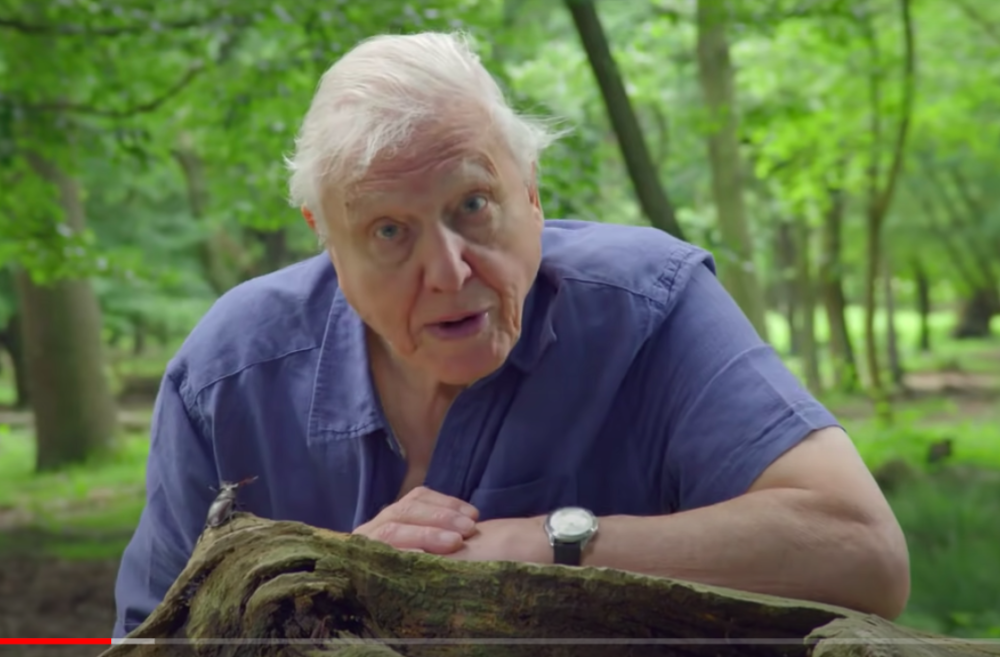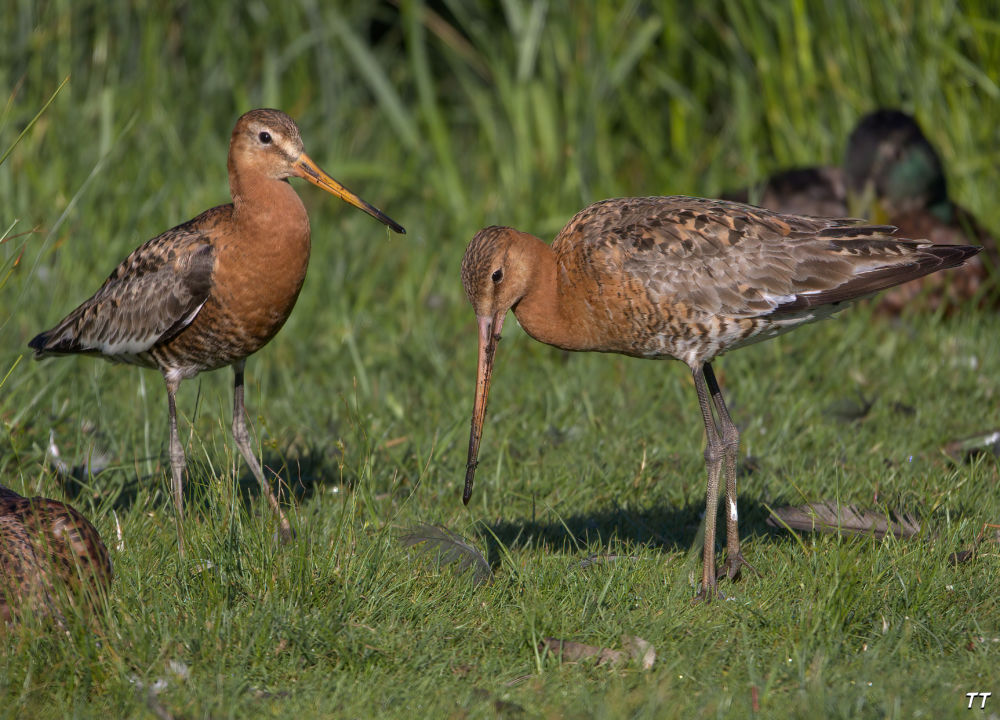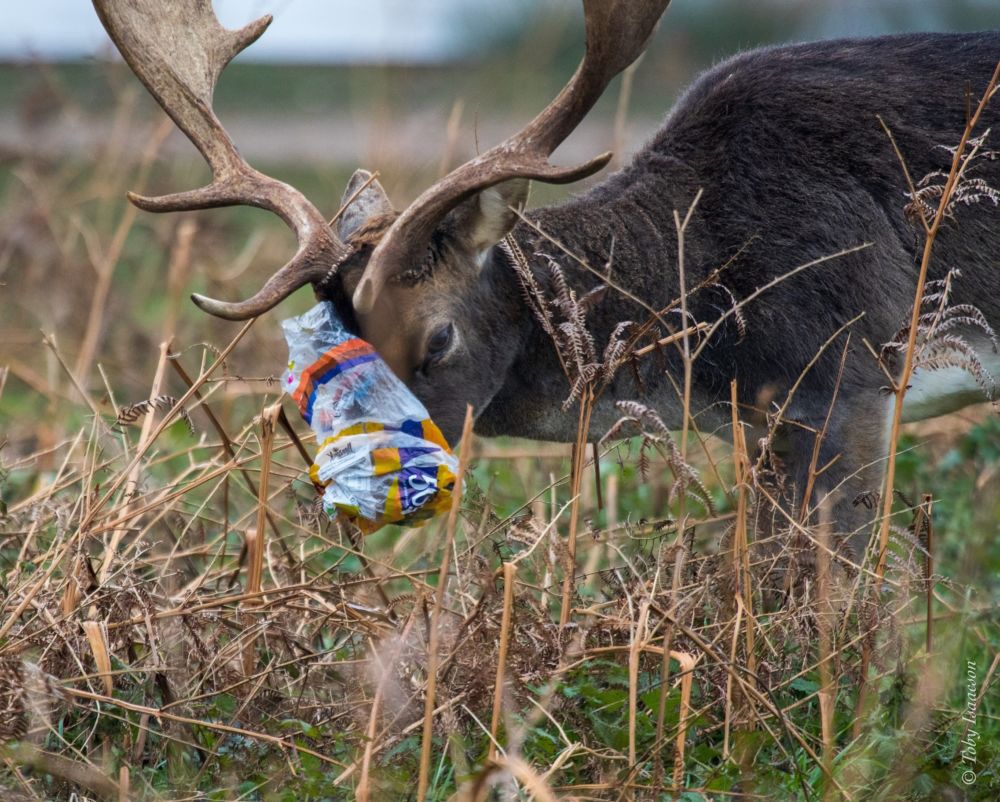Photo: Litter, a danger to wildlife ©TRP
“Leave no trace” Royal Parks campaign launched
The Royal Parks has launched a new campaign to urge visitors to take litter home to protect the wildlife. The campaign highlights the impact of discarded trash on wildlife as part of the ‘Help Nature Thrive’ campaign. It asks visitors to ‘leave no trace’ and to take their rubbish home or put it in the bins if there is space.
In the last year 1,982 tonnes of waste were collected from across the Royal Parks – that’s the equivalent weight of 157 new London Routemaster buses.
 The campaign is supported with a quote from our patron, Sir David Attenborough, who says:
The campaign is supported with a quote from our patron, Sir David Attenborough, who says:
“In busy London, the Royal Parks are a haven for wildlife and there are simple things we can all do to protect it and help it thrive. Litter, and especially plastic, is a growing danger to wildlife worldwide, and we can all help by taking it home or using the bins. Please also leave the wildflowers and fungi, the acorns and deadwood where they are; all of them are vital parts of the Parks’ ecology. Remember to tread lightly and leave no trace of your visit.”
Dogs off leads
The Royal Parks’ requirement for dogs to be on leads at all times, and in all areas of the Park, has been relaxed from 2 August. Dog walkers must still ensure that their dogs are always under control, and keep them on leads around ponds or sensitive areas, to avoid injury to wildlife.
The Royal Parks receives £2,255,000 funding
The Royal Parks has received £2,255,000 funding from the government. It is one of 20 organisations that have received culture recovery funding totalling £60m. Details of the announcement are here.
Tom Jarvis, Director of Parks at The Royal Parks, said:
“We are very grateful to receive this government funding which will help us protect and improve the landscapes of the parks, particularly where they have become so eroded in the last year. Part of the funding will also go towards increasing the parks’ biodiversity through the creation of new nature and wildlife habitats, and a significant amount will go towards repairing and maintaining the historic boundary walls, bridges and reservoirs. The parks have been a lifeline for many during the pandemic, and this funding will help make sure that their natural and historic landscapes continue to be enjoyed safely by visitors now and in the future.”
A good part of the money will come to Richmond Park and will fund recovery of the landscape including new paths, substantial wall repairs and habitat improvements, so expect to see works going on around the Park over the next year. The Royal Parks are recruiting a project team to design and deliver the improvements.
Daniel Hearsum, Friend and restorer of Pembroke Lodge
In our May Bulletin we reported the sad passing of Daniel Hearsum who restored and ran Pembroke Lodge for the last 25 years. He was a good friend to Richmond Park and the Friends. A recent Times newspaper article recounts Daniel’s early life and how he sympathetically restored and extended Pembroke Lodge, from a dilapidated building to its former glory as a magnificent Georgian mansion. See the article HERE (scroll down to the History section and it’s the second item).
Tree Walks
The popular tree walk guides are on sale at the Visitor Centre. There are 8 different walks and the guides are available in packs of 4 at £5 per pack. They’re great value and provide lots of information, perfect for an enjoyable stroll in the Park. More details here.
2022 Calendar, postcards and Christmas Cards
The much cherished Friends of Richmond Park Calendar is in production. As always, the calendar will contain an array of beautiful photographs of Richmond Park and its wildlife, a truly original artwork with all images donated by local photographers.
Our ever popular and original Richmond Park Christmas Cards are also being produced again this year. Look out for further details on the calendar and the Christmas cards.
But you don’t have to wait for our Richmond Park postcards. Now in stock at the Visitor Centre there are new designs as well, as old favourites – beautiful photographs by our local photographers.
New opening times for the Visitor Centre
The Visitor Centre is now open six days a week: Tuesday to Sunday 09.45 to 16.00. It will be closed on Mondays (but open on bank holiday Mondays).
Discoverers’ Summer Expedition event 8 August
This Discoverers’ event in August has proved very popular and is now fully booked. Look out for future events.
Rangers update
The Richmond Park Rangers scheme continues to grow with 52 active volunteer rangers in May and Rangers active in 29 of the 31 days in May. From the return of Rangers to the Park on 8 March to the end of June, the Rangers volunteered for 644 hours in Richmond Park and had 5,711 visitor engagements. The increased use of mentors will help with induction and training of new rangers.
London Duathlon
This year’s Duathlon event is scheduled for Sunday 5 September. Over 3,000 participants are expected – a big demand given no event last year, increased exercise in lockdown and a general desire to do something. As in previous Duathlons, the Park’s roads will be closed to all traffic – including road cyclists (the Tamsin Trail will remain open). Signage about road closures will be put up a fortnight beforehand. Pedestrians in the Park will find parts of the park particularly peaceful – though crossing the roads (busy with cyclists/runners) may not be straightforward. Read more
Safer Parks Panel – incidents update
In mid-July the Safer Parks Panel held its regular quarterly meeting which focused on Apr-Jun police activity including crimes and road accidents. The Panel’s membership includes The Metropolitan Police, The Royal Parks, The Friends and representatives from users of the Park and local councils.
Among about 2,400 breaches of Royal Parks Regulations logged in April to June were:
- 885 verbal warnings given to people harassing deer;
- 292 trades vehicles given tickets;
- 269 parking tickets (i.e. parking outside a car park);
- 188 verbal warnings and 12 Park Regulation Notices* for cyclists speeding;
- 155 verbal warnings and 23 Park Regulation Notices for off-track cycling;
- 94 verbal warnings and 136 Park Regulation Notices re dogs on lead/ failure to control; and
- 4 Park Regulation notices about dogs harassing deer.
Road traffic incidents:
Over Apr-Jun the Parks Police recorded 15 road traffic incidents. Note that these are not necessarily a complete record of all incidents, they are only those that the Parks Police have come across or an ambulance has attended.
- 11 of these (73%) were single cyclist, or cycle-cycle;
- 1 involved a cycle and a pedestrian (a young girl crossing the road by Roehampton Gate car park was hit by a cyclist);
- 1 involved a car and a pedestrian (the car manoeuvring around the Broomfield Hill road barriers had a low-impact collision with an off-duty police officer);
- 1 was cycle-car (cycle collided with a car coming down Dark Hill and turning into Kingston Gate car park); and
- 1 involved a horse only (while on a horse track, a horse spooked and threw its rider).
*Parks Regulations Notices: name and address taken, kept on database for 12 months, prosecuted if caught again.
Black-tailed Godwits – rare visitors!

Black-tailed Godwits, by Warren Richardson
On the 15th July two Black-tailed Godwits were present briefly at Upper Pen Pond. These beautiful long-legged, long-billed waders, a little over 40cms in height, are more a common winter visitor to our estuaries and coastal lagoons, but also appear at wetland sites inland. These rare visitors to the Park were of the Icelandic subspecies, denoting where they primarily breed. They spent some of their time feeding on the grass by the pond before being harassed by a flock of gulls and departing, only the Park’s fourth record in the past seventy years.
Free minibus service
The free Richmond Park minibus service restarted on Wednesday 21 July and will continue every Wednesday until 27 October. The 16 seater minibus stops at each of the car parks, plus Ladderstile and Richmond gates, as well as one stop outside Roehampton Gate (Danebury Avenue) and two stops in Ham (Ham Common and Ashburnham Road). For full details and timetable click here.
Freebord – The Deer’s Leap
Walk out of Roehampton Gate and turn immediately left down the alley towards Palewell Common, or leave Bishop’s Gate and turn right along the passage. You’re now on the Park’s freebord. Richmond Park’s freebord was established when it was enclosed in 1637 and is a ‘rod’ wide (the old medieval measurement, equal to 16 ½ feet or about 5 metres). More romantically, it’s also known as the ‘deer’s leap’ – the story being that if an escaping deer managed to leap beyond the freebord it would no longer be on Park land and could not be recaptured. Read more about this fascinating piece of Richmond Park’s history here on our Articles and facts page (scroll down to the History section). The article appeared first in our summer newsletter.
Guided Walks
Our free guided walks do not need to be booked ahead. Walks begin at 10am and finish around midday at the same car park or gate. Please keep dogs under control. The next 3 walks are:
7 August Kingston Gate car park
4 September Roehampton Gate car park
2 October Sheen Gate Car Park (plus walk the wall)
See full programme details.
Friends’ membership
The Friends’ membership is continuing to grow at around 10% per year. It now stands at more than 3,500 members (assuming 2 people for each household membership). Please encourage your friends, family and neighbours to join us www.frp.org.uk/membership/
RICHMOND PARK DIARY – AUGUST 2021
©TRP
Pen Ponds causeway closed from 16th August
The causeway will be closed for approximately 8 weeks. Contractors will be undertaking work to raise the height of the causeway. This will improve the structural integrity of the reservoir to hold back water in the event of a ‘one in thousand year’ flood. Contractors will need to close the causeway to enable work as machinery will be in operation and aggregates and other material will be delivered. The Royal Parks appreciate that the causeway provides a very desirable section for many routine walks. However, pedestrians will not be able to walk through the work site for obvious safety reasons.
Park roads closed on Sunday 5 September for the London Duathlon
The event attracts about 3000 participants who run, cycle and then run again on the park roads over a variety of distances. The event starts and finishes near Roehampton Gate and this area will be busier than usual. Whilst the park gates, roads and car parks are closed to vehicles, the park is still open for walkers and generally quieter than most weekends.
Hay-making
Some areas of the park grassland were fertilised with sewage sludge back in the 1980’s. This was done to improve the fertility of the soil and increase the volume of grass produced for the deer to eat. At the time the park wasn’t designated as a Site of Special Scientific Interest and there were far more deer in the park. Whilst this was well-intended, we now understand that improving the soil, favours a smaller diversity of grass species and reduces the abundance and diversity of other species. We therefore cut hay on the ‘improved’ areas and don’t apply any fertilisers. As the hay is taken away, and over time, the soil gradually reduce in fertility and a better sward diversity is encouraged. The hay making contractors always cut our hay late in the season after skylarks have nested. They must plan the work as part of a season cutting several sites and it all depends on the weather as to exactly when they will be on site. As they say – make hay whilst the sun shines.
Harebells
These attractive bell-shaped blue flowers are currently blooming. The name derives from it living closely alongside Hares in grassland and folklore states that Harebells chime to warn the Hares of danger. Well, not loudly enough even for the large ears of Hares, who were last seen in the Park in 1972. Local names include Witches’ Bells, Harvest Bells, Heath Bell, Cuckoo’s Thimble, Fairy Caps and Granny’s Tears. In Scotland they are known as Blue Bells, but in the south of England ‘Blue Bell’ is saved for the woodland flower that blossoms early in the year. It is also considered unlucky to pick them – especially for Hares!
THE ISABELLA PLANTATION IN AUGUST
©TRP
Magnolia grandiflora – Occupies a secluded glade to the south of Thomson’s Pond. It has large white flowers with a delicious fragrance set amongst glossy evergreen leaves. Petals fall to reveal striking seed heads.
Clethra alnifolia – The Sweet Pepper Bush, also fragrant, is opposite the tall pine below the gate to Broomfield Hill and also below Thomson’s Pond.
Hydrangea quercifolia – on the Birthday Mound and elsewhere, has panicles of white flowers, and foliage resembling coarse oak leaves, which takes on rich Autumn colours later in the year.
Hydrangea paniculata ‘Tardiva’ – also bears panicles of white flowers and is set in woodland near the gate towards Pen Ponds, and elsewhere in the Garden.
Hydrangea aspera subsp. Sargentiana – grows in Wilson’s Glade in the north east corner, this upright gaunt shrub bears broad heads of flowers from late summer to mid-autumn, the inner ones are blue or deep purple, the outer ones are large and white.
Sorbaria kirilowii – also found in Wilson’s Glade produces white flowers in large conical panicles throughout July and August.
Heptacodium miconioides – Is a vigorous shrub that bears lightly scented clusters of white flowers throughout late summer and early autumn. It can be found growing below Thomson’s Pond and also on the Birthday Mound.
Calycanthus occidentalis – grows at the top end of the Old Nursery. This Californian species bears large red-brown flowers throughout the summer.
Summer flowering shrubs in the Heather Garden include varieties of Erica vagans, the Cornish Heath, such as ‘Mrs. Maxwell’ – dark pink; ‘Rosea’ – light pink; and ‘Cornish Cream’ – cream. Several varieties of Calluna vulgaris have coloured foliage, such as ‘Gold Haze’ – white flower and gold leaf; and ‘Robert Chapman’ – purple flower with bronze foliage. Daboecia cantabrica has white or purple waxy bells.
Along the streams many native marginal plants are in flower, such as Purple and Yellow Loosestrife, Meadowsweet, Greater Willowherb and Hemp Agrimony. These wildflowers, along with the heathers, attract many butterflies. Elsewhere, streamside clumps of Hemerocallis, the Day Lily, produce a succession of tall yellow or orange trumpet-shaped flowers throughout July and August; each flower lasting only a day.
Thompson’s Pond and the Bog Garden have fine stands of Pontederia cordata, the Pickerel Weed, with spikes of blue flowers amongst erect spear-shaped leaves.
![]()
Heptacodium Miconioides ©TRP


